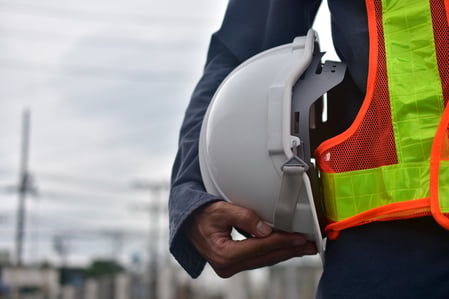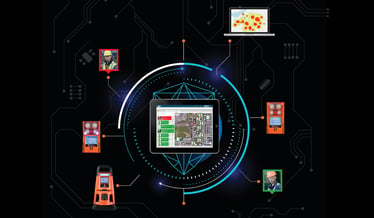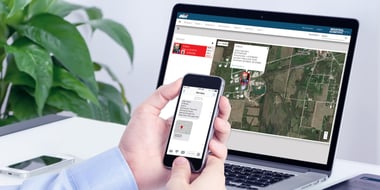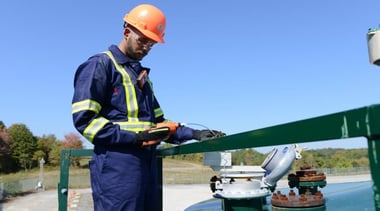Workplace safety is constantly evolving, especially in fast-moving industrial environments. Thanks to technological advancements, what was considered safe 10 or 20 years ago often doesn’t hold up to present-day safety standards.
This is especially true for gas detection systems. While up-to-date gas detection systems cannot eliminate every safety challenge, when paired with proper training, they can make your site significantly safer for workers.
If you are on the fence about upgrading your gas detection program or don’t know if your system is up to date, consider this comparison of traditional versus cutting-edge gas monitoring systems.
Traditional Gas Detection Systems No Longer Cut It
 Gas detection hardware is built to handle the wear and tear of industrial environments, so it is fairly common to see personal monitors and area gas monitors that are 10 or 20 years old and still functioning. Safety supervisors may be thrilled to see that their investment was worth every penny and has stood the test of time, but there is always a point where the pennies stop adding up and your outdated tech begins costing your company.
Gas detection hardware is built to handle the wear and tear of industrial environments, so it is fairly common to see personal monitors and area gas monitors that are 10 or 20 years old and still functioning. Safety supervisors may be thrilled to see that their investment was worth every penny and has stood the test of time, but there is always a point where the pennies stop adding up and your outdated tech begins costing your company.
When reviewing your gas monitoring program, one of the first things to look for is whether your devices have up-to-date firmware or if the monitors are still running their original firmware. Why should you care? Manufacturers offer firmware updates to fix a bug that you might not have noticed or to add important capabilities. If your gas detectors are no longer receiving firmware updates, you’ve reached the first and most important sign that it’s time to upgrade before out-of-date equipment puts your workers at risk.
Older gas detectors are also more likely to experience sensor issues, leading to inaccurate calibration or even bump tests. Carrying a monitor with failing sensors can give your workers a false sense of security that may prove even more dangerous than not carrying a monitor at all.
Sticking with an outdated gas detection system also limits you in several other ways:
1. Manual Processes
You would never overlook efficiency and productivity at your site, yet you might be doing just that by sticking with an old gas monitoring system. Outdated gas detection systems often rely on time consuming, manual processes that can be automated with the standard technology in newer gas monitoring systems. Speed and accuracy are critical for maximizing your return on investment (ROI), but these two factors also play a significant role in worker safety as every second counts when there are hazards present.
Gas monitors are fundamental to worker safety because they constantly monitor gas exposure and warn workers when levels become dangerous—equipment failure in the field can make the difference between life and death. That’s why it’s crucial to keep your gas monitors in the best possible shape with regular maintenance and management. With such high stakes, manual maintenance can have serious limitations.
Manually marking instruments with due dates and manually tracking event logs, data records, and calibration gas status is time consuming and subject to human error—or even shortcuts by employees. The larger your fleet of gas detectors, the longer this process takes and the more valuable man hours you lose in the process.
2. Clunky Software
Advancements to hardware may initially seem more obvious, but the software that newer devices run is just as important. Think about it: if you’ve ever used an old computer or smartphone that’s a few years old, then you understand the difference that software improvements can make. When it comes to software, something that’s just a few years outdated can suddenly feel like a relic from the stone ages.
The same is true when it comes to outdated gas detection systems. Older designs may be unintuitive or unresponsive, not to mention much slower at detecting hazardous gases. Workers cannot afford to contend with clunky, unresponsive software when they are performing dangerous work in a hazardous environment. You wouldn’t bet your life on a phone that’s 10 to 20 years old, so you shouldn’t do the same with your gas detection system.
3. Lack of Visibility
Do you know where all your workers are at any given time? Do you know which worker was exposed to hydrogen sulfide and who had a health emergency and triggered their panic alarm?
Outdated gas monitors limit your ability to share valuable data and alarms between workers and their response team or safety managers. Without real-time visibility into the status of your workers, you’re essentially driving blind.
It’s useful to think about gas monitors as one piece of a larger safety system at your workplace, rather than equipment used by individual workers who are solely responsible for their next steps if a hazard is detected.
While no visibility was simply the status quo for many decades, new connected safety solutions offer significantly more visibility into your locations and workers, so you can have their backs when they need it – even if they are miles away.
What is a Connected Gas Monitoring System?
A connected gas monitoring system uses flexible connectivity options like peer-to-peer, Bluetooth, wi-fi, LTE-5G, 4G, satellite, and more to join personal gas monitors and any area or fixed gas monitors with software tools that make your job easier.
Connected safety programs can include device management data, real-time hazard data, and analytics insights to give you control over your company’s safety and productivity from anywhere.
With a platform approach to gas detection, you can easily and quickly harness the power of the data your gas monitors collect to respond faster during emergencies, cut down manual processes, notice patterns in safety incidents, and proactively reduce risks.
What You Gain by Upgrading
New gas detection systems that use connected safety technology offer significant benefits over traditional gas detection systems:
1. Automated Processes
Safety managers know the pain of handling piles of paperwork from gas detection records. Even with a good manual system in place, it’s tedious to track regulatory compliance, identify hazards workers are exposed to on-site, and provide historical data when incidents do occur. Add to that the fact that these records don’t contain key information, like the name of the worker exposed or where the exposure took place, and it’s like solving a mystery every time you review your data.
Gas detection management software, like iNet® Control, eliminates these challenges by helping you identify hazards and manage compliance. With one simple dashboard, you can easily manage your people and equipment while collecting key data about gas hazards on your site.
Some of the key information you can access in iNet Control include equipment status, bump test and calibration reports for streamlined auditing, and alarm trends by time, length, and user.
The efficiency you gain by implementing modern gas detection software is great for the company’s budget and even better for your workers’ safety.
2. Instrument Management
Maintaining gas monitors regularly makes the difference between life and death. Bump tests and calibrations, instrument repair, and safety records are all key to proper gas detection management, but many businesses struggle with them because traditional approaches tend to be hands on and labor intensive.
That’s why a comprehensive maintenance subscription service like iNet® Exchange is so valuable. You can let the experts handle your gas detector maintenance and repair, shipping, calibration gas, docking stations, training, and more, freeing you up to make safety decisions and focus on other priorities. You can automate regular maintenance, like bump tests and calibrations, with the click of a button and generate safety records and certificates in seconds.
To make your life even easier, iNet Exchange automatically tracks monitor performance sensor function, shipping you a new instrument immediately as soon as one of yours starts to decline, so you’re never left with frustrating troubleshooting or the task of finding spare monitors in a pinch.
3. Improved Worker Communication
 It’s no longer sufficient for employees to carry personal gas monitors at all times. New technologies connect entire teams of workers, sharing alarms between devices and alerting everyone to dangerous gas levels. When time is critical and communication is key, instant alarm sharing is a literal life saver.
It’s no longer sufficient for employees to carry personal gas monitors at all times. New technologies connect entire teams of workers, sharing alarms between devices and alerting everyone to dangerous gas levels. When time is critical and communication is key, instant alarm sharing is a literal life saver.
A simple communication network like LENS® Wireless can connect all personal and area gas monitors at a site to enhance team-based safety. Everyone will instantly know who is in trouble and why, so workers can make smarter, faster, safer decisions.
LENS Wireless creates a dependable, self-healing mesh network with minimal setup and no IT involvement, ensuring workers are connected even if a few units drop off.
4. Real-Time Visibility
Every aspect of a connected safety program is designed to give you real-time visibility into your site and workers so you can take the right action at the right time.
Software like iNet® Now Live Monitoring gives you real-time text, email, or onscreen alerts every time a worker is exposed to dangerous gases on your site. You can see this activity on a map that highlights the location and condition of each worker, so you always have total visibility into the safety of your workers. Real-time worker status updates eliminate manual check-ins so your workers can focus on the job. With all this information at your fingertips, you can save time in emergencies and make sure your workers get the help they need.
However, you can’t always be available to respond to worker alerts. When that’s the case, (especially for lone workers and workers in different time zones or locations), there are also real-time monitoring solutions. With 24/7 Professional Monitoring, you can rely on agents to escalate incidents according to a custom response plan around the clock. When an alarm is triggered on a worker's gas detector, an agent will pursue the alert until it's resolved. You can ensure your workers get the help they need, even when you can’t be there.
Overall, by building up a safety program that fits your needs and works together as a complete system, you can better protect your workers from gas hazards on the field while reducing time spent on mundane tasks like routine maintenance and compliance reporting paperwork. You can scale a gas monitoring system to fit your team’s needs and empower your company to streamline operations and build a strong strategy for continuous safety improvements.
To learn more about creating a connected safety platform at your site, download our technology brief: Improve Safety and Optimize Gas Detection Operations.




